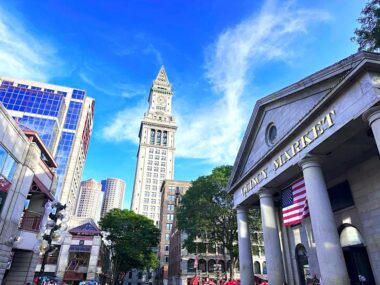Tips on accessible travel following a recent trip to Boston
An AADC deficiency meetup prompts observations about accessibility

My full and undivided attention was dedicated to navigating the stroller over cobblestone sidewalks. When I reached the end, I executed a 180-degree motion so that the back wheels descended the high curb first since there was no ramp. Potholes, stairs, and crowds were some of the other challenges we encountered while traveling to a new city.
Like other children diagnosed with aromatic l-amino acid decarboxylase (AADC) deficiency, our daughter, Rylae-Ann, has limited movement and coordination. Before having gene therapy, she completely depended on my wife, Judy, and me to care for her. She had very little voluntary movement and required a special needs stroller.
Fortunately, Rylae-Ann received gene therapy when she was 18 months old. Since then, she is making progress but still becomes easily fatigued and has trouble with balance. Children who have not had gene therapy require a special needs stroller or a wheelchair. This is why families will need to research a city’s accessibility ratings and features when planning vacations.

Downtown Boston shimmers in the summer sun during the author’s recent Fourth of July vacation. (Photo by Richard E. Poulin III)
A trip to Boston
During the Fourth of July holiday, Judy and I hosted an AADC deficiency meetup in Boston to conclude our Caregiver Lifestyle Series for families in the United States. I did not consider the accessibility of the city before I arrived. But after two days there, I spent an evening Googling to prepare for the arrival of the other families.
One of the first things I found was the accessibility rating of cities. Singapore, our previous home, was at the top of the list, which I can confirm is true. When we lived there, Rylae-Ann was still an infant. I loved how effortless it was to navigate the smooth sidewalks that connected to buildings, parks, and mass transit systems. I naively took many of those features for granted.
Boston did not make the list, which I believe is due to the city’s history and age. Its historical areas remain true to the past, but an unintended result is a visual comparison of how far inclusion has come. This contrast does not help families traveling with wheelchairs.
Although the city is friendly for walking, it is not, in my opinion, a stroller- or wheelchair-friendly city. Nevertheless, several destinations have great accessibility features.
“Lonely Planet” offers a free online accessibility travel guide that helped us plan which areas to visit. We also discovered that official state tourism websites had dedicated pages with accessible information for popular travel destinations in the city. After finding inclusive tourist areas, we could use taxis, buses, or the subway.
Online reviews and guides are helpful, but each child and situation are unique. In education, we do a risk assessment before any field trip. Teachers first visit a field trip site to assess safety, bathroom locations, and potential hazards. Judy applied the same logic to our vacation. While I watched Rylae-Ann nap, my wife visited some of the potential spots.
Based on her visit, we could decide which location offered the best experience while also being inclusive of our group’s needs. She also knew where the bathrooms were, spots to eat, and areas we could rest if necessary. I appreciate all the online resources, but nothing is better than having eyes on the ground if you can work it in.

Rylae-Ann poses next to a “Make Way for Ducklings” statue during a family trip to Boston. (Photo by Richard E. Poulin III)
Improving accessibility information
A lot goes into planning a holiday, which is even more cumbersome for AADC deficiency families. Thankfully, there are many online resources to help make visits more enjoyable.
After our trip, I contributed reviews to many of the major travel guides, and I will continue to add feedback in the future. As you travel to new destinations, tap into these resources, but be sure to add your feedback.
Note: AADC News is strictly a news and information website about the disease. It does not provide medical advice, diagnosis, or treatment. This content is not intended to be a substitute for professional medical advice, diagnosis, or treatment. Always seek the advice of your physician or other qualified health provider with any questions you may have regarding a medical condition. Never disregard professional medical advice or delay in seeking it because of something you have read on this website. The opinions expressed in this column are not those of AADC News or its parent company, BioNews, and are intended to spark discussion about issues pertaining to aromatic l-amino acid decarboxylase deficiency.






Comments